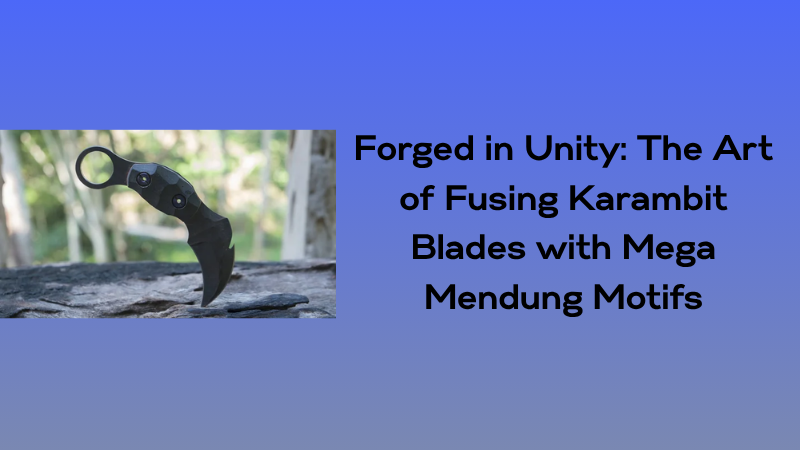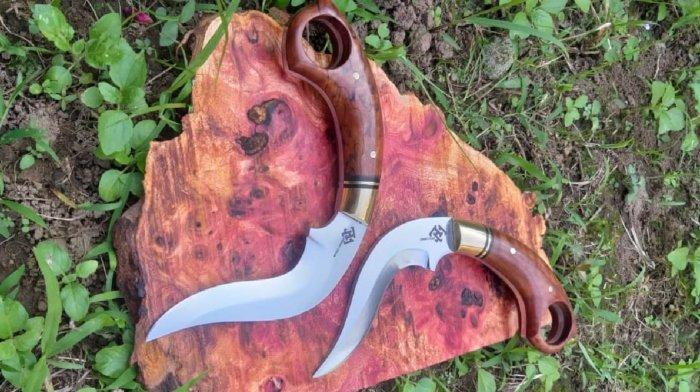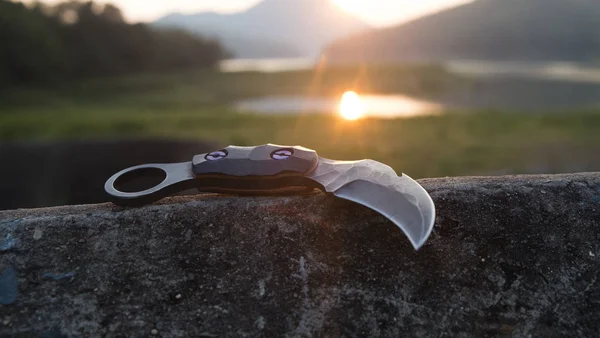
Forged in Unity: The Art of Fusing Karambit Blades with Mega Mendung Motifs
Introduction: Where Steel Meets Cloud

In a stunning fusion of Sumatra's martial heritage and Java's textile artistry,
artist Bagus Rohmadi Maulana undertook a groundbreaking project: transforming
the lethal karambit dagger into a vessel of cultural dialogue.
His 2020 thesis project, "Exploration of Karambit Form with Mega Mendung
Motif as an Artwork," presented at the Indonesian Institute of the Arts
Yogyakarta, resulted in six breathtaking pairs of functional art pieces. This
project transcended mere craftsmanship; it became a powerful statement that
cultural differences are bridges, not barriers. By meticulously casting brass
blades adorned with the iconic Javanese cloud motif, Maulana proved that the
beauty of Indonesia lies in its intricate, interconnected tapestry.
The Karambit: Sumatra's Deadly Curved Legacy
- Origins & Function: The karambit is a small, curved blade originating from West Sumatra, historically used by the Dharmasraya to Pagaruyung dynasties. Designed for close combat and ambush, its lethality stems from its compact, easily concealed form and distinctive ergonomics.
- Deadly Design: The inward-curving blade (often nearing 90 degrees) allows for devastating hooking, slashing, and stabbing motions. Its small size makes it difficult for enemies to detect, often hidden within clothing. Crucially, the ring at the end of the hilt secures the weapon to the user's finger, preventing slippage during intense combat – a vital feature for its effectiveness in traditional silat martial arts.
- Cultural Symbol: More than just a weapon, the karambit served as a protector for travelers and migrants, embodying self-reliance and cultural identity from West Sumatra.
Mega Mendung: Java's Majestic Cloud Motif
- Cirebon Roots: The Mega Mendung (meaning "Cloudy Sky") motif is a hallmark of Cirebon batik in West Java. Its origins represent a fascinating cultural syncretism.
- A Fusion of Influences: The motif evolved from Chinese Ming Dynasty porcelain designs featuring dragons and clouds, brought to Java through ancient trade routes. Adapting to Islamic teachings prohibiting depictions of living beings, Javanese artisans abstracted and transformed these elements, focusing solely on the powerful, billowing cloud forms.
- Aesthetic & Symbolism: Characterized by asymmetrical compositions and rhythmic, balanced cloud formations, Mega Mendung evokes grandeur, tranquility, and divine power. The bold, layered cloud shapes ("gumpalanawan yang tegas") are its most prominent feature.
The Artistic Vision: Bridging Sumatra and Java
Maulana's core mission was twofold:
- Cultural Revival: To elevate awareness of both the karambit's history and the Mega Mendung motif's significance, bringing them to a wider audience beyond their regional origins.
- Symbolic Fusion: To consciously merge two distinct Indonesian cultural icons – the Sumatran karambit representing martial tradition and the Javanese Mega Mendung representing artistic textile heritage. This fusion aimed to symbolize national unity and the idea that cultural differences should foster connection, not division ("perbedaanbudayabukanlahalasanuntuktidaksalingmengenalsatusama lain").
- Functional Art: To transform a traditionally lethal object into a piece of fine art, suitable for appreciation in gallery settings, while retaining its inherent form and craftsmanship.

Methodology: Brass, Fire, and Precision
Maulana employed a Practice-led Research methodology, documenting the artistic process, experiments, challenges, and solutions. Key techniques included:
- Brass Casting (Cor Kuningan): The primary technique. Molten brass (an alloy of copper and zinc, melting point 900-940°C) was poured into clay molds created using lost-wax (lilin) models. Cement molds were used to duplicate wax models, anticipating casting defects.
- Engraving (Teknik Grafir): Used to refine and enhance the Mega Mendung motifs on the cast brass blades, ensuring clarity and detail, especially where the initial casting was imperfect. This engraving functioned similarly to the "pamor" (damascene patterns) on a keris.
- Finishing Techniques:
- Lawasan: Dipping the brass into Hydrochloric Acid (HCL), burning it dry, and repeating to achieve a deep, antique black patina. This added an aged, mystical quality.
- Silver Plating (Sepuh Perak): Used on pieces like "Stabber" and "Slasher" to coat brass surfaces with silver using heat or electrolysis, creating contrast.
- Handle Materials: Diverse woods (Damar, Dutch Teak/Jati Belanda, Coconut) and resin were chosen for ergonomics, aesthetics, and their ability to absorb finishes. Synthetic leather cord was also used.
- Design Process: Involved extensive sketching based on aesthetic principles and art function theory, consultation with advisors, design refinement, prototyping in wood to perfect size and comfort, and overcoming technical hurdles like trapped air in complex castings.
The Six Masterpieces: A Gallery of Fusion
Each pair of karambits embodies a unique form and concept, unified by the Mega Mendung motif on the blade:
- Reaper (Pencabik): (13.3 x 9 cm) Aggressive form with sharp angles and points. Damar wood handle (soft texture) counterbalances the aggressive blade. Represents overflowing anger and ambition. The engraving adapts the sharp cloud tips ("ujungawan yang lancip") of Mega Mendung.
- Slasher (Penyayat): (11 x 10 cm) Features a deep, near-semicircular curve. Dutch Teak handle (absorbs black finish well) highlights the brighter blade. Represents toughness and determination. Engraving emphasizes the motif's sharp cloud points.
- Slaughter (Pembantai): (26 x 25 cm) Monumental size (twice normal), curved near 90 degrees. Coconut wood handle (hard, tiger-stripe-like grain). Represents influential women, drawing on Islamic philosophy (ribs) and Minangkabau matrilineal systems. Features prominent Mega Mendung engraving.
- Stabber: (Details from overall context) Underwent silver plating finishing. Name implies a focus on thrusting capability.
- Slicer: (Details from overall context) Name implies a focus on cutting/slashing capability.
- Breaker: (Details from overall context) Name implies a focus on power or breaking defenses.
All pieces feature the Mega Mendung engraving as "pamor," enhancing beauty and cultural resonance. Handle choices prioritized ergonomic comfort alongside aesthetic contrast or complementarity to the blade's form and finish.
Challenges and Creative Solutions
The creation process wasn't smooth:
- Wood Prototype Sizing: Initial wooden models were too small and uncomfortable. Solution: Iterative testing to find the optimal ergonomic size.
- Casting Defects: Complex designs trapped air bubbles, causing flaws, especially at the blade base. Solution: Creating excess wax models using cement molds to account for defective casts.
- Engraving Necessity: Casting imperfections sometimes blurred the intricate Mega Mendung motifs. Solution: Using engraving techniques to cleanly define the patterns post-casting.
- Finishing Inconsistencies: Some final finishes didn't perfectly match the original designs due to the reactive nature of the techniques (especially Lawasan).
Conclusion: A Legacy Cast in Brass and Culture
Bagus Rohmadi Maulana's project stands as a remarkable achievement in Indonesian contemporary craft. By successfully merging the formidable karambit of Sumatra with the ethereal Mega Mendung motif of Java through masterful brass casting and engraving, he created more than just weapons or art objects. He forged symbols of unity.

The six pairs of karambits – Slaughter, Reaper, Breaker, Stabber, Slicer, and Slasher – each tell a story through their unique forms, material choices, and names, yet are bound together by the shared language of the cloud motif etched onto their brass blades. This project powerfully embodies the applied social function of art, particularly as an expression of ideology: demonstrating that Indonesia's diverse cultures can intertwine to create something new, beautiful, and profoundly meaningful. The karambit, once solely an instrument of combat, now also serves as an ambassador of cultural harmony, its curved blade a testament to the enduring power of artistic fusio
